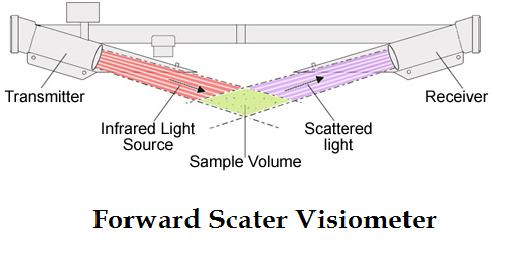About this page
How visibilty is measured on light vessels and other automatic weather stations.
Preamble
Meteorological observing has long been a combination of instrumental measurement and descriptive observation. Because of increasing manpower costs, the need to obtain data more frequently, and in often hostile or remote environments, there has been much development of automatic observing systems. These now include measurements of amount and height of cloud and the present weather eg is it raining? Visibility is important to the sailor and this page describes, briefly, how visibility instruments work and how well they work.
Related pages
On this page -
What do we Mean by Visibility?
The human observer on dry land measures visibility by determining the greatest distance at which he can distinguish objects, ideally black, against the horizon sky with the unaided eye. At night, an equivalent is obtained by using lights of known intensities at various distances. At sea the Officer of the watch has no fixed reference points unless, of course, the visibility is very poor and he is using the various objects on deck. In reasonable visibility he uses his long experience by looking at the horizon and seeing how sharp it is, trying to see other vessels that he has detected on his radar and so on. At night, he will use the brightness of the stars, how well he can see the cloud, the clarity of lights on board and so on.
The ability to distinguish objects by day or see lights at night is determined by scattering of light by dust, smoke, water and other particulate matter in the air. The greater the scattering of light, the poorer will be the visibility. The extreme case is dense fog at night when light is scattered directly back at your car headlights.
Of course, there is a certain amount of subjectivity and much will depend upon eyesight and the skill and experience of the observer. I would have been a very poor officer of the watch!
Using Scattering to Measure Visibility
At automatic stations, such as those used on light vessels, there are various ways of measuring this scattering effect. First, there are forward scatter instruments. These emit a beam of light and sensors a little way off the direct, narrow beam, measure only light that has been scattered. Poor visibility leads to more scattering and, therefore, more light at the sensors. The poorer the visibility, the greater the signal. The next technique, known as back scattering, is in use on British motorways where observant drivers will have seen sensors alongside the carriageway. These measure light scattered directly back to the source and, again, the greater the received light the poorer is the visibility. This technique is particularly useful for fog and the sensors are used to activate fog warning signs.
A third system, using instruments known as transmissometers, measures the light loss, due to scattering, by putting the sensors in the direct beam. Here the less light received by the sensor then the poorer is the visibility. Each sensor type has its particular virtues but the forward scatter visibility sensors on the light-vessels were chosen by the Met Office as being reliable, robust and not unduly affected by salt spray contaminating the optics. They are good at measuring the visibility well throughout a large range although, perhaps, slightly inferior to the other techniques at very poor visibilities. This is not too critical at sea where anything below 1000 metres is, effectively, fog and defined as such by meteorologists. The same definition is also used for aviation. To a car driver visibility really only becomes a hazard at much lower values, say around 200 metres. For this reason, "fog" in forecasts for the general public refers to visibilities of less than 200 metres.
Where are Visibility Instruments used?
The moored buoys that are used to the west of the UK on the edge of the Continental Shelf, although large, are not big enough to carry these instruments. But most automatic stations on land and large platforms at sea are increasingly being fitted with visibility sensors. At manned stations they are also used although here the observer can override the instrument if he believes that the value is not realistic or representative. The rules for human observers define visibility as the least value around the horizon.
Those who sail close to Sandettie Light Vessel in the Dover Strait, Greenwich Light vessel on a crossing to the baie de Seine or Channel Light Vessels at the western end of the Casquets separation zone, can do their own checks. The measurements usually look good to me. The main shortcoming of automatic visibility measurements is that they only sample the air at the instrument. They do not “see” that bank of fog rolling in! So, be on your guard.
Return to Home Page

